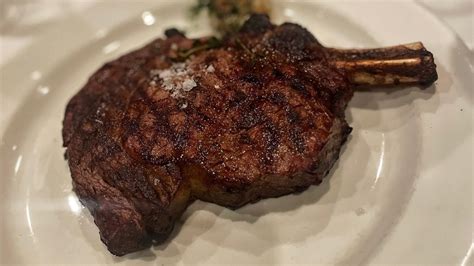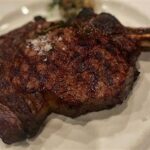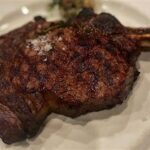
Home to reportedly the largest portions in the United States, Old Homestead Steakhouse in New York City, established in 1868, might be the reason doggie bags became a cultural norm, with their massive cuts of meat often requiring patrons to take leftovers home.
New York City’s iconic Old Homestead Steakhouse, a culinary landmark dating back to 1868, isn’t just famous for its aged prime beef and historical ambiance; it’s equally renowned for serving portions so generous they’ve practically institutionalized the doggie bag. For over a century and a half, this family-run establishment in the heart of the Meatpacking District has been dishing out steaks and sides that consistently challenge diners to consume everything on their plates, leading many to wonder if Old Homestead is indeed the inadvertent originator of the take-home container.
Located at 56 Ninth Avenue, the Old Homestead Steakhouse has witnessed the evolution of New York City from horse-drawn carriages to yellow taxis and from gas lamps to neon lights. Throughout its storied history, the restaurant has remained a constant, a testament to the enduring appeal of classic American cuisine, particularly high-quality steak cooked to perfection. However, beyond the exceptional food and impeccable service lies a legacy of oversized portions that have, over time, made the doggie bag an essential part of the Old Homestead experience.
According to Marc Sherry, co-owner of Old Homestead, the portions served at the restaurant are, without exaggeration, enormous. “Our steaks are huge; our sides are plentiful. People come here expecting to be satisfied, and we make sure they are,” Sherry explained. The restaurant’s signature cuts, like the colossal 32-ounce Gotham Ribeye or the tender, melt-in-your-mouth Filet Mignon, are prime examples of this philosophy. Paired with equally generous sides like creamy mashed potatoes, colossal onion rings, and steamed asparagus, a meal at Old Homestead is an exercise in gastronomic indulgence.
The practice of taking leftovers home, while common today, wasn’t always the norm. In the early days of dining out, restaurants often served smaller, more manageable portions, and the concept of taking food home was considered somewhat impolite or even déclassé. However, Old Homestead’s commitment to providing exceptional value and ensuring customer satisfaction led them to serve portions that often exceeded what a single person could comfortably consume in one sitting. Faced with the prospect of wasting perfectly good food, patrons began requesting to take their leftovers home, a practice that the restaurant readily accommodated.
Over time, this practice evolved into the widespread use of doggie bags, becoming an accepted and even expected part of the dining experience. While it’s impossible to definitively prove that Old Homestead invented the doggie bag, its role in popularizing the concept is undeniable. The sheer volume of leftovers generated by the restaurant’s generous portions likely played a significant role in normalizing the practice, influencing other restaurants to adopt similar policies.
The Old Homestead’s enduring legacy extends far beyond its sizable steaks and historical significance. It’s a symbol of New York City’s culinary heritage, a place where generations of families have gathered to celebrate special occasions and enjoy a classic American meal. The restaurant’s commitment to quality, consistency, and generous portions has earned it a loyal following and solidified its place as one of the city’s most beloved institutions.
In an era of fleeting trends and culinary experimentation, Old Homestead remains steadfastly committed to its core values. The restaurant continues to serve the same classic dishes that have made it famous, prepared with the same attention to detail and served in the same generous portions. While the city around it has changed dramatically, Old Homestead has remained a constant, a reminder of a time when quality, value, and tradition were paramount.
The restaurant’s history is as rich and flavorful as its steaks. Founded in 1868 by German immigrants, the Old Homestead originally served as a neighborhood saloon and eatery, catering to the working-class residents of the Meatpacking District. Over the years, it evolved into a full-fledged steakhouse, attracting a diverse clientele that included celebrities, politicians, and everyday New Yorkers.
During the Prohibition era, the Old Homestead operated as a speakeasy, serving illicit liquor behind closed doors. Despite the risks involved, the restaurant remained a popular gathering place, offering a sense of normalcy and camaraderie during a tumultuous time. After Prohibition was repealed, the Old Homestead resumed its legal operations, solidifying its reputation as one of the city’s most reliable dining establishments.
Throughout the 20th century, the Old Homestead continued to thrive, weathering economic downturns, changing tastes, and the challenges of operating a business in a rapidly evolving city. The restaurant’s success can be attributed to its unwavering commitment to quality, its loyal customer base, and its ability to adapt to changing times without compromising its core values.
Today, the Old Homestead is owned and operated by the Sherry family, who have carried on the restaurant’s traditions for generations. Marc Sherry and his brother, Greg, are dedicated to preserving the restaurant’s legacy, ensuring that future generations can enjoy the same exceptional food and impeccable service that have made it a New York City institution.
The restaurant’s menu features a wide variety of classic steakhouse dishes, including prime-aged steaks, fresh seafood, and hearty sides. The steaks are cooked to perfection in a custom-built broiler, ensuring that each cut is tender, juicy, and full of flavor. The sides are prepared with the same attention to detail, using only the freshest ingredients.
In addition to its regular menu, the Old Homestead also offers a selection of daily specials, showcasing seasonal ingredients and creative culinary innovations. The restaurant’s wine list features a diverse selection of domestic and international wines, carefully chosen to complement the menu.
The Old Homestead’s atmosphere is warm, inviting, and steeped in history. The restaurant’s décor features dark wood paneling, vintage photographs, and antique fixtures, creating a sense of timeless elegance. The service is attentive, professional, and personalized, ensuring that each guest feels welcomed and valued.
Whether you’re a seasoned steak connoisseur or a first-time visitor, the Old Homestead offers an unforgettable dining experience. From the exceptional food and impeccable service to the restaurant’s rich history and vibrant atmosphere, every aspect of the Old Homestead is designed to impress.
The impact of Old Homestead extends beyond the culinary world, influencing popular culture and shaping the dining habits of generations. The restaurant has been featured in numerous films, television shows, and books, cementing its status as a cultural icon. Its name has become synonymous with quality, tradition, and generous portions, a reputation that the restaurant has worked hard to earn and maintain.
Old Homestead’s contribution to New York City’s culinary landscape is immeasurable. It’s a place where memories are made, traditions are upheld, and the spirit of the city is celebrated. As long as there are people who appreciate a great steak and a warm welcome, the Old Homestead will continue to thrive, serving as a testament to the enduring power of classic American cuisine.
While fine dining establishments exist throughout the city, Old Homestead’s history, ambiance, and unwavering commitment to quality and quantity set it apart. It’s a place where the past and present converge, where tradition and innovation coexist, and where the simple pleasure of a perfectly cooked steak is elevated to an art form.
The restaurant’s location in the Meatpacking District also contributes to its unique appeal. Once a gritty industrial area, the Meatpacking District has undergone a dramatic transformation in recent years, becoming a trendy neighborhood known for its upscale boutiques, art galleries, and vibrant nightlife. Despite these changes, the Old Homestead has remained a constant, a reminder of the neighborhood’s working-class roots.
The Old Homestead’s success is a testament to the power of perseverance, dedication, and a unwavering commitment to quality. In a city known for its fast-paced lifestyle and ever-changing trends, the Old Homestead has managed to stay true to its roots, providing a consistent and reliable dining experience for over a century and a half.
The restaurant’s story is a reminder that some things never go out of style. Good food, good service, and a warm welcome are timeless values that will always be appreciated. The Old Homestead has mastered these values, creating a dining experience that is both memorable and satisfying.
The next time you find yourself in New York City, be sure to visit the Old Homestead Steakhouse. Experience the legendary portions, savor the exceptional food, and soak in the restaurant’s rich history and vibrant atmosphere. You’ll understand why the Old Homestead has been a New York City institution for over a century and a half. You may even leave with a doggie bag, carrying a piece of culinary history home with you.
The generous portions served at Old Homestead extend beyond the steaks. The sides, appetizers, and desserts are all equally abundant, ensuring that no one leaves the restaurant hungry. From the overflowing shrimp cocktail to the decadent chocolate cake, every dish is designed to satisfy even the most voracious appetite.
The Old Homestead’s commitment to generous portions is not just a marketing gimmick; it’s a reflection of the restaurant’s philosophy. The Sherry family believes in providing exceptional value for their customers, ensuring that they leave feeling satisfied and well-cared for. This commitment to value has been a key factor in the restaurant’s long-term success.
The Old Homestead’s impact on the doggie bag culture is undeniable. While other restaurants may have contributed to the trend, the Old Homestead’s consistent practice of serving oversized portions likely played a significant role in normalizing the practice. The restaurant’s influence can be seen in the widespread use of doggie bags throughout the restaurant industry.
The Old Homestead’s story is a reminder that sometimes the simplest things can have the biggest impact. A commitment to quality, a dedication to service, and a willingness to serve generous portions have made the Old Homestead a New York City icon. Its legacy will continue to inspire future generations of restaurateurs.
The restaurant’s enduring appeal lies in its ability to balance tradition and innovation. While the Old Homestead has remained true to its core values, it has also adapted to changing times, incorporating new technologies and culinary techniques. This ability to evolve while staying true to its roots has been a key factor in the restaurant’s long-term success.
The Old Homestead’s story is a testament to the power of family ownership. The Sherry family’s passion for the restaurant is evident in every aspect of the business, from the quality of the food to the warmth of the service. Their dedication to preserving the restaurant’s legacy has made it a New York City treasure.
The Old Homestead’s impact on the Meatpacking District is also significant. The restaurant has been a fixture in the neighborhood for over a century, weathering numerous changes and challenges. Its presence has helped to preserve the neighborhood’s unique character and history.
The Old Homestead’s story is a reminder that success is not just about making money; it’s also about building relationships and creating a sense of community. The restaurant has fostered a loyal following over the years, creating a community of diners who appreciate its exceptional food, impeccable service, and warm atmosphere.
The Old Homestead’s legacy will continue to inspire future generations of restaurateurs, demonstrating the power of quality, service, and tradition. The restaurant’s story is a reminder that some things never go out of style, and that the simple pleasure of a great meal shared with friends and family will always be cherished.
Marc Sherry’s pride in the Old Homestead is palpable. “We’re not just selling steaks; we’re selling an experience,” he says. “We want people to come here and feel like they’re part of our family.” This commitment to creating a welcoming and memorable dining experience has been a key factor in the restaurant’s long-term success.
The Old Homestead’s impact on the culinary world is undeniable. It’s a place where traditions are upheld, memories are made, and the simple pleasure of a perfectly cooked steak is celebrated. As long as there are people who appreciate quality, service, and tradition, the Old Homestead will continue to thrive, serving as a testament to the enduring power of classic American cuisine.
The restaurant’s location, 56 Ninth Avenue, is steeped in history, adding to the Old Homestead’s unique appeal. The Meatpacking District, once a hub of industrial activity, has transformed into a vibrant neighborhood known for its trendy boutiques, art galleries, and lively nightlife. Yet, amidst these changes, the Old Homestead remains a steadfast reminder of the area’s working-class roots.
The Old Homestead’s success is a testament to the unwavering dedication of the Sherry family and their commitment to maintaining the restaurant’s high standards. Their passion for providing exceptional food and service is evident in every detail, ensuring that each guest has a memorable dining experience.
The Old Homestead’s legacy extends far beyond its oversized portions. It’s a symbol of New York City’s culinary heritage, a place where generations have gathered to celebrate special occasions and enjoy a classic American meal. The restaurant’s enduring appeal lies in its ability to blend tradition with innovation, offering a timeless dining experience that continues to captivate diners from around the world.
The impact of the Old Homestead on popular culture cannot be overstated. The restaurant has been featured in numerous films, television shows, and books, solidifying its status as a cultural icon. Its name has become synonymous with quality, tradition, and generous portions, a reputation that the restaurant has diligently cultivated over the years.
The Old Homestead’s contribution to New York City’s culinary landscape is immeasurable. It’s a place where memories are created, traditions are honored, and the spirit of the city is celebrated. As long as there are those who appreciate a great steak and a warm welcome, the Old Homestead will continue to thrive, serving as a testament to the enduring power of classic American cuisine.
Frequently Asked Questions (FAQ)
1. Is Old Homestead Steakhouse really the oldest steakhouse in America?
Yes, Old Homestead Steakhouse claims to be the oldest steakhouse in America, established in 1868. This assertion is widely reported and accepted, although verifying such claims definitively can be challenging due to the age of the establishment and potential gaps in historical records.
2. What makes the portions at Old Homestead so large?
According to Marc Sherry, co-owner of Old Homestead, the portions are intentionally large as part of the restaurant’s philosophy of providing exceptional value and ensuring customer satisfaction. The restaurant aims to leave patrons feeling completely satisfied with their dining experience. The cuts of meat are exceptionally generous, and the sides are equally plentiful.
3. Did Old Homestead Steakhouse invent the doggie bag?
While it is difficult to definitively prove that Old Homestead invented the doggie bag, the restaurant’s consistently large portions likely played a significant role in popularizing the concept. The sheer volume of leftovers generated by the restaurant’s generous servings led patrons to request taking food home, normalizing the practice and influencing other restaurants to adopt similar approaches.
4. What are some of the signature dishes at Old Homestead Steakhouse?
Some of the signature dishes at Old Homestead Steakhouse include the 32-ounce Gotham Ribeye, the Filet Mignon, creamy mashed potatoes, colossal onion rings, and steamed asparagus. These dishes are known for their high quality and generous portions.
5. What is the atmosphere like at Old Homestead Steakhouse?
The atmosphere at Old Homestead Steakhouse is described as warm, inviting, and steeped in history. The décor features dark wood paneling, vintage photographs, and antique fixtures, creating a sense of timeless elegance. The service is attentive, professional, and personalized, contributing to a memorable dining experience.









